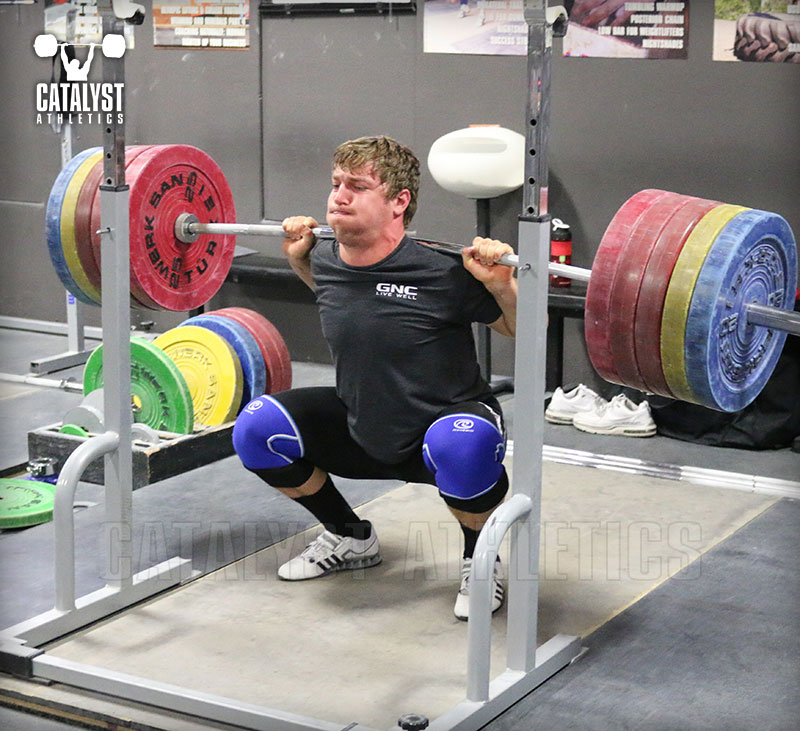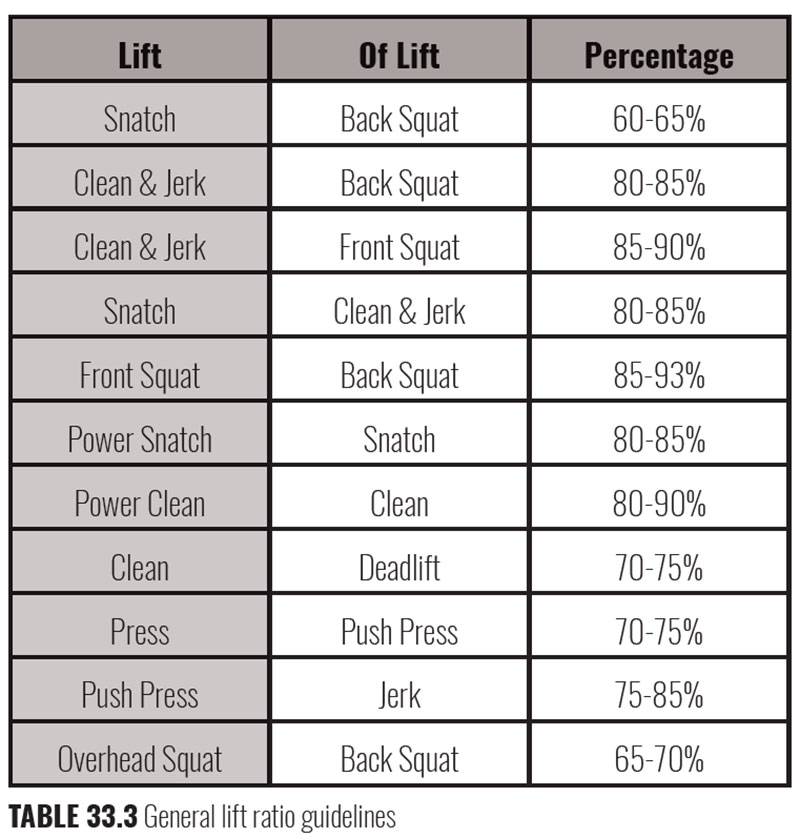Articles
The Relation of Snatch, Clean & Jerk and Squat Weights
May 22 2013

May 22 2013

How much should I snatch and clean & jerk if I back squat this much? This is a question I get a lot, and there isn't a simple, formulaic answer. Put simply, it depends on your own strengths and weaknesses. I have seen enormous ranges even just in my own gym, let alone outside of it.
You will have bigger classic lifts relative to your squat if you are:
1. Explosive
2. Technically proficient
3. Experienced in weightlifting
4. Naturally athletic (i.e. coordinated, good at motor skill development, etc.)
You will have a bigger gap between your classic lifts and your squats if you are:
1. Not very explosive (but possibly still very strong)
2. Not technically proficient
3. New to weightlifting
4. Not naturally athletic
Obviously, being strong helps with weightlifting - it's a strength sport. But the goal is finding the right balance between general strength and the ability to apply it to the snatch and clean & jerk, because it is not always a parallel relationship. Having enormous differences between your classic lifts and squats after the beginner stage, however, is indicative of a problem (such as not being technically sound or even just being inflexible).
As a very loose guideline, I would like to see the back squat be about 125-135% of the clean, and the snatch about 78-83% of the clean & jerk. The benefit of having an even larger back squat will be generally easier snatches and clean & jerks at a given weight... but then that might arguably mean those snatch and clean & jerk weights should be heavier.
Reasons for the snatch and clean & jerk ratios being off can vary, but here are a few.
The snatch may fall below the range relative to the clean & jerk if:
1. The athlete is short-limbed, especially the arms
2. The athlete has poor snatch bottom position mobility
3. The athlete’s bodyweight is high for his/her height
4. The athlete is less explosive than strong
5. The athlete has incomplete elbow extension
The snatch may fall above the range if:
1. The athlete is tall and/or long-limbed
2. The athlete’s bodyweight is too low for his/her height
3. The athlete is more explosive than strong
4. The athlete’s squat strength is limited
Some of these of course can’t be fixed—if you have long arms, for example, you just have long arms. Others, such as improper bodyweight for height or flexibility, can be addressed through training and nutrition.
Below are some loose guidelines. Again, if you fall outside a range, don't panic. Figure out why so you can determine if it's actually a problem, or reflective the expected result of some kind of natural trait.

The solution is to look at each athlete individually and try to decide what is really holding them back at any given point. Are they technically sound and fast and lifting a large percentage of their squat weights? Then emphasizing increasing squat strength is a good strategy. Are they really strong squatters who aren't snatching and clean & jerking as much relatively? Then emphasizing technique, speed and maybe pulling strength is a more appropriate strategy.
And, of course, the total is what truly matters in the sport of weightlifting—how an athlete makes it is irrelevant. If a lifter’s total is progressing satisfactorily over time and existing gaps are not increasing significantly, then there’s no use losing sleep over imperfect ratios among the various lifts. This is not to say that programming can’t be adjusted to gradually nudge the numbers closer to optimal, but it can be a subtle process over the long term rather than drastic remediation.
Bottom line: Don't get too hung up on relative numbers to any precise degree. Instead, use them as one of many diagnostic tools to help guide your program design for each individual.
You will have bigger classic lifts relative to your squat if you are:
1. Explosive
2. Technically proficient
3. Experienced in weightlifting
4. Naturally athletic (i.e. coordinated, good at motor skill development, etc.)
You will have a bigger gap between your classic lifts and your squats if you are:
1. Not very explosive (but possibly still very strong)
2. Not technically proficient
3. New to weightlifting
4. Not naturally athletic
Obviously, being strong helps with weightlifting - it's a strength sport. But the goal is finding the right balance between general strength and the ability to apply it to the snatch and clean & jerk, because it is not always a parallel relationship. Having enormous differences between your classic lifts and squats after the beginner stage, however, is indicative of a problem (such as not being technically sound or even just being inflexible).
As a very loose guideline, I would like to see the back squat be about 125-135% of the clean, and the snatch about 78-83% of the clean & jerk. The benefit of having an even larger back squat will be generally easier snatches and clean & jerks at a given weight... but then that might arguably mean those snatch and clean & jerk weights should be heavier.
Reasons for the snatch and clean & jerk ratios being off can vary, but here are a few.
The snatch may fall below the range relative to the clean & jerk if:
1. The athlete is short-limbed, especially the arms
2. The athlete has poor snatch bottom position mobility
3. The athlete’s bodyweight is high for his/her height
4. The athlete is less explosive than strong
5. The athlete has incomplete elbow extension
The snatch may fall above the range if:
1. The athlete is tall and/or long-limbed
2. The athlete’s bodyweight is too low for his/her height
3. The athlete is more explosive than strong
4. The athlete’s squat strength is limited
Some of these of course can’t be fixed—if you have long arms, for example, you just have long arms. Others, such as improper bodyweight for height or flexibility, can be addressed through training and nutrition.
Below are some loose guidelines. Again, if you fall outside a range, don't panic. Figure out why so you can determine if it's actually a problem, or reflective the expected result of some kind of natural trait.

The solution is to look at each athlete individually and try to decide what is really holding them back at any given point. Are they technically sound and fast and lifting a large percentage of their squat weights? Then emphasizing increasing squat strength is a good strategy. Are they really strong squatters who aren't snatching and clean & jerking as much relatively? Then emphasizing technique, speed and maybe pulling strength is a more appropriate strategy.
And, of course, the total is what truly matters in the sport of weightlifting—how an athlete makes it is irrelevant. If a lifter’s total is progressing satisfactorily over time and existing gaps are not increasing significantly, then there’s no use losing sleep over imperfect ratios among the various lifts. This is not to say that programming can’t be adjusted to gradually nudge the numbers closer to optimal, but it can be a subtle process over the long term rather than drastic remediation.
Bottom line: Don't get too hung up on relative numbers to any precise degree. Instead, use them as one of many diagnostic tools to help guide your program design for each individual.

Thanks, this is a great article! Was relieved to see that my lifts are on track relative to my back squat. Recently started playing with a cambered bar to hopefully increase leg strength.
Cheers!
Thanks for writing this article. What about a scenario where you've got a guy who is technically proficient, flexible, and back squats more than 150% of his max clean? Would this really be indicative of a problem or could the discrepancy be brought down with proper programming? If it is programming related, any suggestions for what to do?
Thanks for your response.
Yes, I would say that's indicative of a problem of some type of the clean. If he's technically proficient and flexible as you say, there is some reason he's not able to use that squat strength as much as he should be able to - it could be as simple as fear of pulling under heavy weights into a deep receiving position.
Yes. Not always, but often.
You can take a look at the qualifying totals for the American Open and Nationals and use that to gauge where you are at.
The qualifying totals can be found at the link here: 0205632.netsolhost.com/2013NationalEventsQualifyingTotals.pdf
It's not really an issue of how long one has been lifting but how far along he/she is in terms of development. I would define a beginner in this context as someone who is still refining the basics of technique and is not proficient or consistent yet. For some, this stage can be very brief (few months) and for others, it can be years.
If that's actually true (I haven't looked at the numbers to confirm it), I could offer two possibilities, and likely a combination of the two: 1) American lifters tend to be taller than their international counterparts in a given weight class, which means better snatching relative to CJ weights, and 2) International lifters tend to start at younger ages, which means longer periods of development prior to and more strength by the age of their biological peaks.
Greg Everett
Greg Everett
Alyssa Sulay
What are some ways to increase push press strength through accessories in your programming and how frequent?